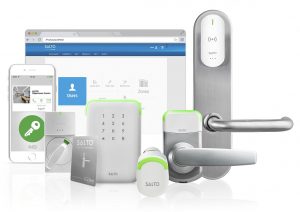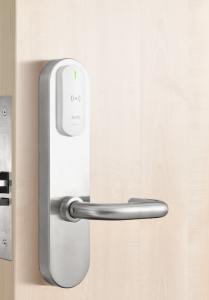The healthcare industry is in constant evolution. Every year brings new or advanced practices, techniques, and resources to the fold that improve both patient outcomes and the delivery of care. This unending transformation is crucial to public health, and today, it is largely driven by smarter, more secure, and connected technologies.
“Technology has transformed the healthcare industry in many different ways,” says Paul Cannon, healthcare industry leader with SALTO Systems. “For many, that transformation is most visible at the patient level, where integrated systems are making building controls and patient information more accessible to medical professionals.”
More importantly, he adds, modern advancements in healthcare technologies are today being designed with a “patient-centered” philosophy. This approach puts patients’ abilities, limitations, challenges, and preferences at the core of their design, leading to solutions that are more aligned with patients’ needs.

Digital innovations can be found throughout the hallways, patient rooms, and operating suites of healthcare. For Cannon and the SALTO Systems team, however, the focus is introducing next-gen building access and security solutions.
“Remote visitor management systems are an important part of building trust and a sense of security in the healthcare space,” he says. “What we’re focused on is bringing smarter, more mobile, and more integrated building security and access control solutions to the sector that do just that.”
 Those solutions, he continues, provide building teams with a suite of building security controls they can access via mobile devices, as well as live video and audio feeds from connected cameras throughout the building. Moreover, these technologies enable authorized hospital staff to virtually manage various hospital activities, such as health screenings, emergency mustering, and attendance recording.
Those solutions, he continues, provide building teams with a suite of building security controls they can access via mobile devices, as well as live video and audio feeds from connected cameras throughout the building. Moreover, these technologies enable authorized hospital staff to virtually manage various hospital activities, such as health screenings, emergency mustering, and attendance recording.
“Importantly, these solutions include mobile credentialing that can control how these security solutions are used, by whom, and to what extent,” Cannon adds. “The result is integrated building security and access control solutions that deliver more control and peace of mind.”
Making peace with tech
Whether securing facilities, enhancing communications, or revolutionizing care, the technology is only effective when it is embraced by actual people. Here again, part of implementing patient-centered technologies is taking measures to bring everyone on board.
 “The first step to introducing any new piece of tech is educating users on the benefits they’ll get from using it,” advises Cannon. “There is always resistance with any new process, so a well thought educational program is critical in gaining the end user’s trust.”
“The first step to introducing any new piece of tech is educating users on the benefits they’ll get from using it,” advises Cannon. “There is always resistance with any new process, so a well thought educational program is critical in gaining the end user’s trust.”
When adopting new technologies in any environment, it helps to have training programs and resources at the ready, gain “buy-in” from the top, as well as enlist “tech champions” among the staff who can help guide others in its adoption.
Technology adoption is also an ongoing process, part of which involves ensuring the tech and associated systems are working as effectively as possible. For this reason, says Cannon, it’s important to make regular monitoring and updating part of one’s schedule: “Being proactive with a defined program allows for fixable problems ahead of time, rather than a potentially larger challenge that may take place once the issue occurs. A good software and hardware maintenance plan will ensure that the software is updated with the latest version and that the hardware is in good working condition.” After all, he warns, “Failure to upgrade these systems can leave openings in the security layer that make it easier for hackers to find vulnerabilities.”
Moving ahead
The healthcare revolution is never over. And much like SALTO’s ongoing mission to rethink building security and access control, innovators in all corners of the industry are seeking ways to take the industry into the future.
“Ultimately, the future of healthcare includes mobile technologies that will integrate multiple systems, such as a patient’s medical history, real-time health updates, insurance coverages, and access control management,” Cannon adds. “And as always, the end-user experience will continue to drive expansion into these newly digitized areas.”






